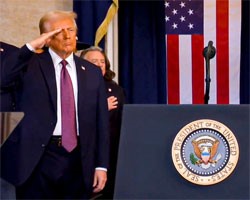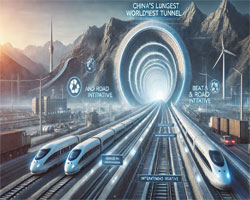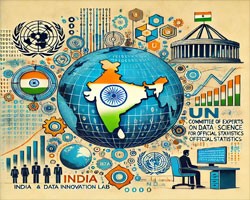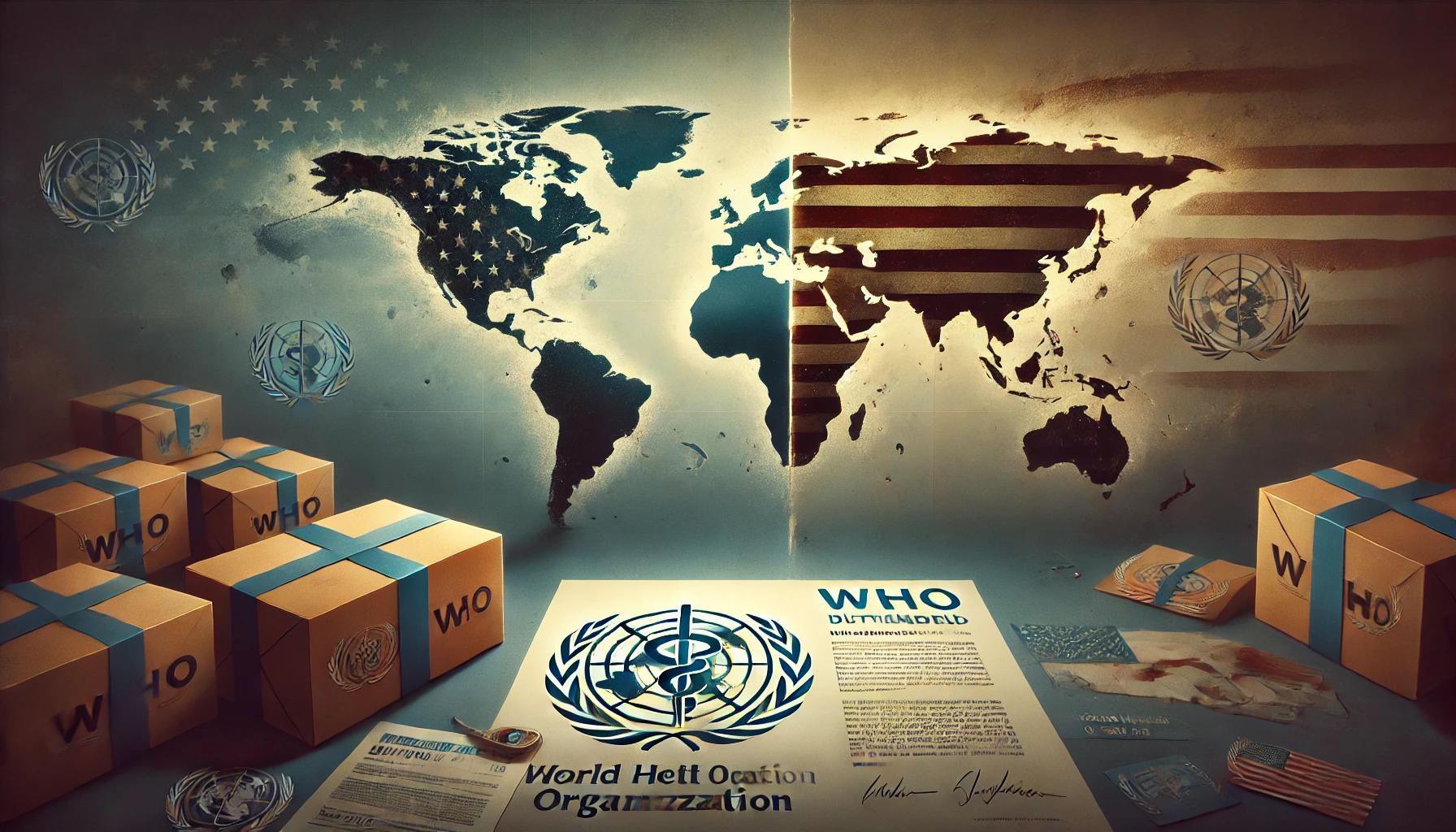SSC Current Affairs
TABLE OF CONTENTS |
| International Relations |
|---|
|
|
|
Why in the News?
Donald Trump was sworn in as the 47th President of the United States on January 20, 2025, marking a historic return to the White House after four years. He becomes the second president after Grover Cleveland to regain the presidency and, at 78, is the oldest U.S. president to take office. Key Takeaways Inauguration Day Highlights The swearing-in ceremony was moved indoors to the Capitol Rotunda due to extreme cold, marking the coldest inauguration day in 40 years. JD Vance was sworn in as Vice President during the ceremony. Trump’s Historic Comeback Overcame multiple impeachments, criminal indictments, and an assassination attempt to secure victory in the 2024 elections. Won every swing state and restored the Republican majority in Congress. Promises for a New Era Trump vowed to sign a record number of executive orders and reverse Joe Biden’s policies. Early agenda includes mass deportations, ending birthright citizenship, banning transgender athletes in women’s sports, and pardoning 2021 Capitol rioters. Global and Economic Implications Trump’s “America First” policies have raised concerns globally, especially in Europe and Ukraine. Markets rallied on his pro-business stance, with Bitcoin hitting an all-time high of $109,241, and energy investors optimistic about deregulation plans. |
|
|
|
What’s the ongoing story:
China has completed the Tianshan Shengli Tunnel, the world’s longest expressway tunnel at 22.13 kilometers. This engineering marvel is part of the Urumqi-Yuli Expressway, significantly enhancing connectivity between northern and southern Xinjiang. The tunnel reduces travel time across the Tianshan Mountains from approximately three hours to just 20 minutes, highlighting China’s focus on infrastructure advancement. Key Points to Ponder: The Tianshan Shengli Tunnel: A Milestone in Infrastructure Development How does the Tianshan Shengli Tunnel revolutionize travel and regional integration within Xinjiang? What technological innovations were employed to overcome the challenges posed by high-altitude and complex geological conditions? The Belt and Road Initiative (BRI): Connecting the World How does the Tianshan Shengli Tunnel align with China’s broader objectives under the BRI? Examine the strategic importance of Xinjiang as a critical node in China’s Silk Road Economic Belt. Environmental Implications: A Balancing Act What measures were taken to protect local ecosystems, including the Tianshan No. 1 Glacier and Urumqi’s water source? Analyze the trade-offs between large-scale infrastructure projects and environmental preservation. Geopolitical and Economic Impact: How does this project bolster China’s geopolitical influence in Central Asia under the BRI framework? What are the economic implications of enhanced connectivity in Xinjiang for trade, investment, and regional development? Key Takeaways: Technological Innovation and Challenges: The construction of the Tianshan Shengli Tunnel involved cutting-edge techniques, including the first use of tunnel boring machines in Chinese road tunnel projects. This innovation enabled the team to navigate complex geological formations and high-altitude conditions. Strategic Infrastructure: The tunnel serves as a crucial link in the Urumqi-Yuli Expressway, enhancing connectivity in Xinjiang. This aligns with China’s BRI strategy to strengthen trade routes and integrate the region with global markets. Environmental Protection: High ecological standards were maintained during construction, with efforts to minimize the project’s environmental footprint and protect wildlife habitats and water sources. Economic Growth: By reducing travel time and improving accessibility, the project is expected to stimulate economic growth in Xinjiang, fostering regional integration and investment opportunities. Do You Know? Belt and Road Initiative (BRI): A Global Vision Launched in 2013, the BRI aims to connect Asia, Europe, and Africa through a network of trade routes. Over 140 countries have signed agreements under this ambitious infrastructure development strategy. Silk Road Economic Belt: The land-based component of the BRI seeks to revive ancient trade routes, connecting China to Europe through Central Asia. China’s Technological Prowess: The Tianshan Shengli Tunnel demonstrates China’s ability to undertake complex engineering projects, reinforcing its position as a global leader in infrastructure development. Xinjiang’s Strategic Role: As a key region in the BRI, Xinjiang serves as a gateway for China’s trade and energy corridors, enhancing connectivity with Central Asia and beyond. |
|
|
|
India has joined the UN Committee of Experts on Big Data and Data Science for Official Statistics (UN-CEBD), which underscores the country’s growing stature in the global statistical community and highlights its commitment to leveraging data and technology for informed decision-making.
The UN-CEBD was created to further investigate the benefits and challenges of Big Data, including the potential for monitoring and reporting on sustainable development goals. India will contribute to shaping global standards and practices in harnessing Big Data and data science for official statistical purposes. India’s engagement will highlight its pioneering initiatives, including the establishment of the Data Innovation Lab. This engagement will also complement India’s ongoing efforts to: Streamline Statistical Production: Drive innovation in data collection, processing, and analysis to reduce the time lag in data availability. Improve Decision-Making: Provide policymakers with real-time insights for evidence-based decisions, addressing key socio-economic challenges. Foster International Collaboration: Share India’s expertise while learning from global best practices to create robust, future-ready statistical frameworks. |
|
|
|
What’s the ongoing story?
On January 20, 2025, President Donald Trump signed an executive order announcing the United States’ withdrawal from the World Health Organization (WHO) and suspending all foreign aid for 90 days. This move has sparked significant global concern, with implications for international health security and U.S. foreign policy. Key Points to Ponder: Why is the U.S. withdrawing from WHO? What are the reasons cited for this decision? Analyze the criticism of WHO’s handling of the COVID-19 pandemic. Discuss the financial disparities and political influence concerns raised by the U.S. Impact of foreign aid suspension: How will the 90-day pause in U.S. foreign aid affect global development initiatives? Examine how this suspension could alter U.S. foreign policy priorities and alliances. Global health implications: How will the withdrawal impact global health initiatives, especially in combating diseases like HIV, malaria, and tuberculosis? What alternative strategies can the global community adopt to fill the funding void left by the U.S.? International reactions: What has been the response of other nations and international organizations to the U.S. decision? Evaluate the long-term impact on global cooperation in addressing health emergencies. Key Takeaways: WHO Withdrawal Justifications: The U.S. administration criticized WHO’s mishandling of the COVID-19 pandemic and alleged political influence from member states like China. Financial contributions were deemed disproportionate, with the U.S. providing 18% of WHO’s budget despite a smaller population compared to China. Foreign Aid Suspension: The 90-day suspension of foreign aid is aimed at reassessing its alignment with U.S. foreign policy objectives. Concerns were raised that previous aid efforts may have destabilized global peace by promoting ideas contrary to harmonious international relations. Global Concerns: Health experts and global leaders warned of setbacks to global health programs, particularly in disease eradication and pandemic preparedness. Germany’s health minister called the withdrawal a "serious setback to international health security." Historical Context: This is not the first time the U.S. has threatened to leave the WHO. A similar decision in 2020 was reversed by President Joe Biden. Do You Know? Impact of U.S. Contributions: The U.S. has been one of the largest donors to the WHO, providing nearly 18% of its budget. This funding supported crucial programs targeting global health crises. Withdrawal Process: The U.S. withdrawal will take up to a year to complete. During this period, the administration plans to identify alternative partners to continue health initiatives. Foreign Aid Statistics: The U.S. is the largest foreign aid donor globally. The suspension will temporarily halt aid programs in developing nations, potentially affecting millions of people. Global Health Funding Gap: The WHO may face funding challenges, which could lead to reduced effectiveness in addressing health emergencies and implementing vaccination campaigns. |
| Important Days |
|
|
|
Why in the news?
The United Nations declared 2025 as the International Year of Glaciers’ Preservation. It has also proclaimed the 21st March of each year as the World Day for Glaciers starting in 2025. Objective: The objective is to raise global awareness about the critical role of glaciers, snow, and ice in the climate system and the hydrological cycle, and the economic, social, and environmental impacts of the impending changes in the Earth’s cryosphere |
|
<< 20-Jan-25
|
|
|




